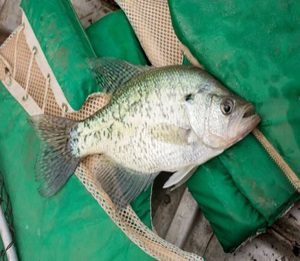
You might be thinking that they can be caught without a fish finder, well yes it’s true, but do you know that if you use one, it can surely help to get you on the fish much quicker and for longer.
Crappies are one of the delicious and most fun to catch fish, plus it’s quite easy to catch as well. So, if you prefer an easy time fishing for crappie then it would be quite useful that you know what they like. Warm water! Crappies like warmer temperatures like summertime and that’s why it’s hard to find better conditions for catching these tasty gamefish than summertime.
How to catch crappie using a fish finder
Once you have successfully installed your fishfinder, you should learn how to read the fish finder screen as well. Without learning how to read a display screen of a fish finder, it would get quite hard for you to catch crappie using a fish finder.
So let’s assume you already know how to read a screen, now you just have to follow some fish finder’s tips for catching crappie, and we assure you that you would have more success the next time that you are out on the water.
Look for shallow, warm water
This one is very important. In order to catch crappie using a fish finder, you need to know the time, place, temperature and areas where crappies are found. Well, the best part is that a good fish finder can help you know about the depth and temperature of the water, which would further lead you to catch more crappie in less time.
Look out for shallow, warm water, using your fishfinder’s temperature and depth gauges. Well, this is explicitly important in the spring when crappie will be clustered in warmer water.
Structure or cover using your fish finder
If you know the right use of your fish finder device, you can catch a lot of crappie by following this simple tip. So when you pull away from shore, just monitor your fish finder for any structure or cover, such as drop-offs or weed lines. According to many experts and researchers, areas with both structure and cover will generally contain the most fish.
Explore deep down
Pro anglers and boaters focus primarily on locating structures using a fishfinder. Try to keep an eye on the depth finder screen and closely look at the bottom of the surface for any sort of irregularities. Crappies are commonly found in such areas. The important thing is that you need to learn how to plot these points on your fishfinder. This will help you circle back to them in the future.
Keep an eye on the screen
Once you find success in locating some structure, check the fishfinder display screen for fish activity. If you are fortunate enough to spot any single fish or small schools of baitfish, that’s a great sign. Plus, Also keep in mind that the fish you spot may or may not be crappie, but the only way to ensure it is to start fishing. It would be better to start out with quick-moving crankbaits, deep-diving, in order to draw any bites.
Make use of map
Watch for humps or reefs that are located in deeper water, because the fish located deep down in the water will have comparatively less competition from other fishermen, hence making them potentially more willing to bite. Well, it is recommended to have a map of the area you plan to fish as it can be difficult to find such areas without a map.
Thanks to fishfinder’s pre-loaded map, if your fish finder has it, it would give you a huge advantage. Now throw some baits around this area for a while to check if you can stir up any crappie. The depth finder screen must be closely watched at this point in order to observe any further fish activity.
Follow zigzag patterns
After locating structures using your fish finder, try to drive your boat over them following a zigzag pattern, while keeping an eye on the fishfinder screen, looking for any other unique structure. The zigzag pattern enables you to effectively cover and plot the area.
Conclusion
Hopefully, you have read the entire article, and probably now you have some idea about how to use a fish finder to catch crappie, or just about any other fish. The process of learning how to use a fishfinder in an effective way is not difficult, it just requires a little bit of focus and practice.
- What Do You Need for Fishing - August 18, 2022
- How to Find Offshore Fishing Spots - August 18, 2022
- What to Use for Trout Fishing - August 17, 2022
